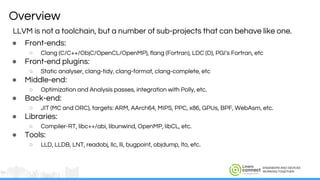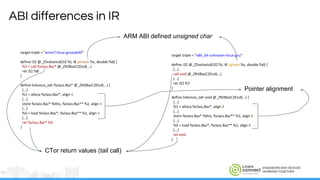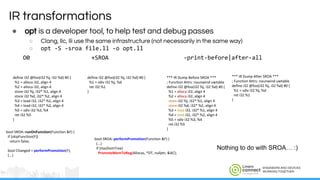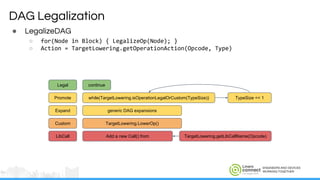BUD17-302: LLVM Internals #2
- 1. BUD17 - 302 Introduction to LLVM Projects, Components, Integration, Internals Renato Golin, Diana Picus Peter Smith, Omair Javaid Adhemerval Zanella
- 2. ENGINEERS AND DEVICES WORKING TOGETHER Overview LLVM is not a toolchain, but a number of sub-projects that can behave like one. ● Front-ends: ○ Clang (C/C++/ObjC/OpenCL/OpenMP), flang (Fortran), LDC (D), PGI’s Fortran, etc ● Front-end plugins: ○ Static analyser, clang-tidy, clang-format, clang-complete, etc ● Middle-end: ○ Optimization and Analysis passes, integration with Polly, etc. ● Back-end: ○ JIT (MC and ORC), targets: ARM, AArch64, MIPS, PPC, x86, GPUs, BPF, WebAsm, etc. ● Libraries: ○ Compiler-RT, libc++/abi, libunwind, OpenMP, libCL, etc. ● Tools: ○ LLD, LLDB, LNT, readobj, llc, lli, bugpoint, objdump, lto, etc.
- 3. ENGINEERS AND DEVICES WORKING TOGETHER LLVM / GNU comparison LLVM component / tools Front-end: Clang Middle-end: LLVM Back-end: LLVM Assembler: LLVM (MC) Linker: LLD Libraries: Compiler-RT, libc++ (no libc) Debugger: LLDB / LLDBserver GNU component / tool Front-end: CC1 / CPP Middle-end: GCC Back-end: GCC Assembler: GAS Linker: GNU-LD/GOLD Libraries: libgcc, libstdc++, glibc Debugger: GDB / GDBserver
- 4. ENGINEERS AND DEVICES WORKING TOGETHER Source Paths Direct route ... … Individual steps clang clang -S -emit-llvmclang -Sclang -c EXE EXE EXE EXE opt IR IR llc ASM OBJ clang lld ASM OBJ clang lld OBJ lld cc1 lld Basically, only two forks... Modulesusedbytools(clang,opt,llc)
- 5. ENGINEERS AND DEVICES WORKING TOGETHER Perils of multiple paths ● Not all paths are created equal… ○ Core LLVM classes have options that significantly change code-gen ○ Target interpretation (triple, options) are somewhat independent ○ Default pass structure can be different ● Not all tools can pass all arguments… ○ Clang’s driver can’t handle some -Wl, and -Wa, options ○ Include paths, library paths, tools paths can be different depending on distro ○ GCC has build-time options (--with-*), LLVM doesn’t (new flags are needed) ● Different order produces different results… ○ “opt -O0” + “opt -O2” != “opt -O2” ○ Assembly notation, parsing and disassembling not entirely unique / bijective ○ So, (clang -emit-llvm)+(llc -S)+(clang -c) != (clang -c) ○ Not guaranteed distributive, associative or commutative properties
- 6. ENGINEERS AND DEVICES WORKING TOGETHER C to IR ● IR is not target independent ○ Clang produces reasonably independent IR ○ Though, data sizes, casts, C++ structure layout, ABI, PCS are all taken into account ● clang -target <triple> -O2 -S -emit-llvm file.c C x86_64 ARM
- 7. ENGINEERS AND DEVICES WORKING TOGETHER ABI differences in IR ARM ABI defined unsigned char Pointer alignment CTor return values (tail call)
- 8. ENGINEERS AND DEVICES WORKING TOGETHER Optimization Passes & Pass Manager ● Types of passes ○ Analysis: Gathers information about code, can annotate (metadata) ○ Transform: Can change instructions, entire blocks, usually rely on analysis passes ○ Scope: Module, Function, Loop, Region, BBlock, etc. ● Registration ○ Static, via INITIALIZE_PASS_BEGIN / INITIALIZE_PASS_DEPENDENCY macros ○ Implements getAnalysisUsage() by registering required / preserved passes ○ The PassManager is used by tools (clang, llc, opt) to add passes in specific order ● Execution ○ Registration order pass: Module, Function, … ○ Push dependencies to queue before next, unless it was preserved by previous passes ○ Create a new { module, function, basic block } → change → validate → replace all uses
- 9. ENGINEERS AND DEVICES WORKING TOGETHER IR transformations ● opt is a developer tool, to help test and debug passes ○ Clang, llc, lli use the same infrastructure (not necessarily in the same way) ○ opt -S -sroa file.ll -o opt.ll O0 +SROA -print-before|after-all Nothing to do with SROA… :)
- 10. ENGINEERS AND DEVICES WORKING TOGETHER IR Lowering ● SelectionDAGISel ○ IR to DAG is target Independent (with some target-dependent hooks) ○ runOnMachineFunction(MF) → For each Block → SelectBasicBlock() ○ Multi-step legalization/combining because of type differences (patterns don’t match) foreach(Inst in Block) SelectionDAGBuilder.visit() CodeGenAndEmitDAG() CodeGenAndEmitDAG() Combine() LegalizeTypes( ) Legalize() DoInstructionSelection() Scheduler->Run(DAG)
- 11. ENGINEERS AND DEVICES WORKING TOGETHER DAG Transformation Before Legalize Types Before Legalize Before ISel “Glue” means nodes that “belong together” “Chain” is “program order” AAPCS R0 R1 i64 “add” “addc+adde” ARMISD 32-bit registers, from front-end lowering
- 12. ENGINEERS AND DEVICES WORKING TOGETHER Legalize Types & DAG Combining ● LegalizeTypes ○ for(Node in Block) { Target.getTypeAction(Node.Type); ○ If type is not Legal, TargetLowering::Type<action><type>, ex: ■ TypeExpandInteger ■ TypePromoteFloat ■ TypeScalarizeVector ■ etc. ○ An ugly chain of GOTOs and switches with the same overall idea (switch(Type):TypeOpTy) ● DAGCombine ○ Clean up dead nodes ○ Uses TargetLowering to combine DAG nodes, bulk of it C++ methods combine<Opcode>() ○ Promotes types after combining, to help next cycle’s type legalization
- 13. ENGINEERS AND DEVICES WORKING TOGETHER DAG Legalization ● LegalizeDAG ○ for(Node in Block) { LegalizeOp(Node); } ○ Action = TargetLowering.getOperationAction(Opcode, Type) Legal Expand Custom LibCall Promote while(TargetLowering.isOperationLegalOrCustom(TypeSize)) TypeSize << 1 continue generic DAG expansions TargetLowering.LowerOp() Add a new Call() from TargetLowering.getLibCallName(Opcode)
- 14. ENGINEERS AND DEVICES WORKING TOGETHER Instruction Selection & Scheduler ● Instruction Selection ○ <Target>ISelLowering: From SDNode (ISD::) to (ARMISD::) ○ <Target>ISelDAGToDAG: From SDNode (ARMISD::) to MachineSDNode (ARM::) ○ ABI/PCS registers, builtins, intrinsics ○ Still, some type legalization (for new nodes) ○ Inline assembly is still text (will be expanded in the MC layer) ● Scheduler ○ Sorts DAG in topological order ○ Inserts / removes edges, updates costs based on TargetInformation ○ Glue keeps paired / dependent instructions together ○ Target’s schedule is in TableGen (most inherit from basic description + specific rules) ○ Produces MachineBasicBlocks and MachineInstructions (MI) ○ Still in SSA form (virtual registers)
- 15. ENGINEERS AND DEVICES WORKING TOGETHER ● Work in progress: GlobalISel ○ IR to (generic) MIR ○ Organized as machine passes, working at the function level ○ More places for the targets to tweak things IR Lowering - New version IRTranslator RegBankSelectLegalizer InstructionSelect Target info Custom passes
- 16. ENGINEERS AND DEVICES WORKING TOGETHER ● IRTranslator: ○ Lowers to generic MIR (G_ADD, G_LOAD, G_BR) ○ Does ABI lowering ● Legalizer: ○ Decides based on type and operation ■ (G_ADD, scalar(32)) -> legal, (G_ADD, scalar(64)) -> narrow scalar ● RegBankSelect: ○ Assigns register banks to help pick better instructions ■ G_LOAD to General Purpose Register or G_LOAD to Floating Point Register ○ Different modes (fast, greedy) ● InstructionSelect: ○ Selects target opcodes and register classes GlobalISel Pipeline IRTranslator RegBankSelectLegalizer InstructionSelect Needs more TableGen!
- 17. ENGINEERS AND DEVICES WORKING TOGETHER Register Allocation & Serialization ● Register allocators ○ Fast: Linear scan, multi-pass (define ranges, allocate, collect dead, coalesce) ○ Greedy: default on optimised builds (live ranges, interference graph / colouring) ○ PBQP: Partitioned Boolean Quadratic Programming (constraint solver, useful for DSP) ● MachineFunction passes ○ Before/after register allocation ○ Frame lowering (prologue/epilogue), EH tables, constant pools, late opts. ● Machine Code (MC) Layer ○ Can emit both assembly (<Target>InstPrinter) and object (<Target>ELFStreamer) ○ Most MCInst objects can be constructed from TableGen, some need custom lowering ○ Parses inline assembly and inserts instructions in the MC stream, matches registers, etc ○ Inline Asm local registers are reserved in the register allocator and linked here ○ Also used by assembler (<Target>AsmParser) and disassembler (<Target>Disassembler)
- 18. ENGINEERS AND DEVICES WORKING TOGETHER Assembler / Disassembler ● AsmParser ○ Used for both asm files and inline asm ○ Uses mostly TableGen instruction definitions (Inst, InstAlias, PseudoInst) ○ Single pass assembler with a few hard-coded transformations (which makes it messy) ○ Connects into MC layer (llvm-mc) and can output text or object code ● MCDisassembler ○ Iteration of trial and fail (ARM, Thumb, VFP, NEON, etc) ○ Most of it relies on TableGen encodings, but there’s a lot of hard-coded stuff ○ Doesn’t know much about object formats (ELF/COFF/MachO) ○ Used by llvm-objdump, llvm-mc, connects back to MC layer
- 19. ENGINEERS AND DEVICES WORKING TOGETHER TableGen ● Parse hardware description and generates code and tables to describe them ○ Common parser (same language), multiple back-ends (different outputs) ○ Templated descriptive language, good for composition and pattern matching ○ Back-ends generate multiple tables/enums with header guards + supporting code ● Back-ends describe their registers, instructions, schedules, patterns, etc. ○ Definition files generated at compile time, included in CPP files using define-include trick ○ Most matching, cost and code generating patterns are done via TableGen ● Clang also uses it for diagnostics and command line options ● Examples: ○ Syntax ○ Define-include trick ○ Language introduction and formal definition
- 20. ENGINEERS AND DEVICES WORKING TOGETHER Libraries ● LibC++ ○ Complete Standard C++ library with native C++11/14 compatibility (no abi_tag necessary) ○ Production in FreeBSD, Darwin (MacOS) ● LibC++abi(similar to libgcc_eh) ○ Exception handling (cxa_*) ● Libunwind(similar to libgcc_s) ○ Stack unwinding (Dwarf, SjLj, EHABI) ● Compiler-RT(similar to libgcc + “stuff”) ○ Builtins + sanitizers + profile + CFI + etc. ○ Some inter/intra-dependencies (with clang, libc++abi, libunwind) being resolved ○ Generic C implementation + some Arch-specific optimized versions (build dep.)
- 21. ENGINEERS AND DEVICES WORKING TOGETHER Sanitizers ● Not static analysis ○ The code needs to be compiled with instrumentation (-fsanitize=address) ○ And executed, preferably with production workloads ● Not Valgrind ○ The instrumentation is embedded in the code (orders of magnitude faster) ○ But needs to re-compile code, work around bugs in compilation, etc. ● Compiler instrumentation ○ In Clang and GCC ○ Add calls to instrumentation before load/stores, malloc/free, etc. ● Run-time libraries ○ Arch-specific instrumentation on how memory is laid out, etc. ○ Maps loads/stores, allocations, etc. into a shadow memory for tagging ○ Later calls do sanity checks on shadow tags and assert on errors
- 22. ENGINEERS AND DEVICES WORKING TOGETHER ● ASAN: Address Sanitizer (~2x slower) ○ Out-of-bounds (heap, stack, BSS), use-after-free, double-free, etc. ● MSAN: Memory Sanitizer (no noticeable penalty) ○ Uninitialised memory usage (suggestions to merge into ASAN) ● LSAN: Leak Sanitizer (no noticeable penalty) ○ Memory leaks (heap objects losing scope) ● TSAN: Thread Sanitizer (5~10x slower on x86_64, more on AArch64) ○ Detects data races ○ Needs 64-bit pointers, to use the most-significant bits as tags ○ Due to multiple VMA configurations in AArch64, additional run-time checks are needed ● UBSAN: Undefined Behaviour Sanitizer (no noticeable penalty) ○ Integer overflow, null pointer use, misaligned reads Sanitizers: Examples
- 23. ENGINEERS AND DEVICES WORKING TOGETHER LLD the llvm linker ● Since May 2015, 3 separate linkers in one project ○ ELF, COFF and the Atom based linker (Mach-O) ○ ELF and COFF have a similar design but don’t share code ○ Primarily designed to be system linkers ■ ELF Linker a drop in replacement for GNU ld ■ COFF linker a drop in replacement for link.exe ○ Atom based linker is a more abstract set of linker tools ■ Only supports Mach-O output ○ Uses llvm object reading libraries and core data structures ● Key design choices ○ Do not abstract file formats (c.f. BFD) ○ Emphasis on performance at the high-level, do minimal amount as late as possible. ○ Have a similar interface to existing system linkers but simplify where possible
- 24. ENGINEERS AND DEVICES WORKING TOGETHER LLD Performance on Large Programs ● Xeon E5-1660 3.2 Ghz, 8 cores on an ssd, rough performance. ● Your mileage may vary, the figures below are from a quick experiment on my machine! ● Smaller programs or those that make heavier use of shared libraries yield much less of a difference. The linker output files below range in size from roughly 1 to 1.5 Gb Program/Linker GNU ld GNU gold lld Clang static debug 1m 17s, 7s non dbg 23s, 2.5 non dbg 6s, 0.9 non dbg libxul.so 27s 10s 2.7s Chromium 1m54s 15s 3.74s
- 25. ENGINEERS AND DEVICES WORKING TOGETHER LLD ELF ● Support for AArch64, amd64, ARM (sort of), Mips, Power, X86 targets ● In the llvm 4.0 release, packages starting to appear in distributions ● Focused on Linux and BSD like ELF files suitable for demand paging ● FreeBSD team have base system (kernel + userspace) running with lld on amd64 ● Linker script support now pretty good ● As of January 2017 20k of 26k of the Poudriere ports linking with lld ● Linaro has a build-bot with lld linking clang, llvm, lld and the test-suite on AArch64 ● ARM is awaiting range-extension thunks (stubs)
- 26. ENGINEERS AND DEVICES WORKING TOGETHER LLD key data structure relationship InputSection OutputSection Contains InputSections InputFile Defines and references Symbol bodies Contains InputSections Symbol Best SymbolBody SymbolBody SymbolTable Global Symbols
- 27. ENGINEERS AND DEVICES WORKING TOGETHER LLD control flow Driver.cpp 1. Process command line options 2. Create data structures 3. For each input file a. Create InputFile b. Read symbols into symbol table 4. Optimizations such as GC 5. Create and call writer Writer.cpp 1. Create OutputSections 2. Create PLT and GOT 3. Relax TLS 4. Create Thunks 5. Assign addresses 6. Perform relocation 7. Write file InputFiles.cpp ● Read symbols LinkerScript.cpp Can override default behaviour ● InputFiles ● Ordering of Sections ● DefineSymbols SymbolTable.cpp ● Add files from archive to resolve undefined symbols
- 28. ENGINEERS AND DEVICES WORKING TOGETHER LLDB ● A modern, high-performance source-level debugger written in C++ ● Extensively under development for various use-cases. ● Default debugger for OSX, Xcode IDE, Android Studio. ● Re-uses LLVM/Clang code JIT/IR for expression evaluation, disassembly etc. ● Provides a C++ Debugger API which can be used by various clients ● Supported Host Platforms ○ OS X, Linux/Android, FreeBSD, NetBSD, and Windows ● Supported Target Architectures ○ i386/x86_64, Arm/AArch64, MIPS/MIPS64, IBM s390 ● Supported Languages ○ Fully support C, C++ and Objective-C while SWIFT and GoLang (under development)
- 29. ENGINEERS AND DEVICES WORKING TOGETHER LLDB Architecture LLDB API LLDB Command line Executable LLDB MI Interface LLDB Python Module Process Plugin Process Thread Registers Memory pTrace Interface L L D B S E R V E R LLDB HOST ABSTRACTION LAYER Linux Android gdb-server MacOSX NetBSD FreeBSD Windows Platform ELF JIT MACH-O PECOFF DWARF Object File Symbols Target Breakpoint LLDB Core LLDB Utility Expressions . Other Plugins ABI Disassembler Expressions Parser Unwinder Instruction Emulation
- 30. ENGINEERS AND DEVICES WORKING TOGETHER References ● Official docs ○ LLVM docs (LangRef, Passes, CodeGen, BackEnds, TableGen, Vectorizer, Doxygen) ○ Clang docs (LangExt, SafeStack, LTO, AST) ○ LLDB (Architecture, GDB to LLDB commands, Doxygen) ○ LLD (New ELF/COFF backend) ○ Sanitizers (ASAN, TSAN, MSAN, LSAN, UBSAN, DFSAN) ○ Compiler-RT / LibC++ (docs) ● Blogs ○ LLVM Blog ○ LLVM Weekly ○ Planet Clang ○ Eli Bendersky’s excellent blog post: Life of an instruction in LLVM ○ Old and high level, but good overall post by Chris Lattner ○ Not that old, but great HowTo adding a new back-end ○ libunwind is not easy!































